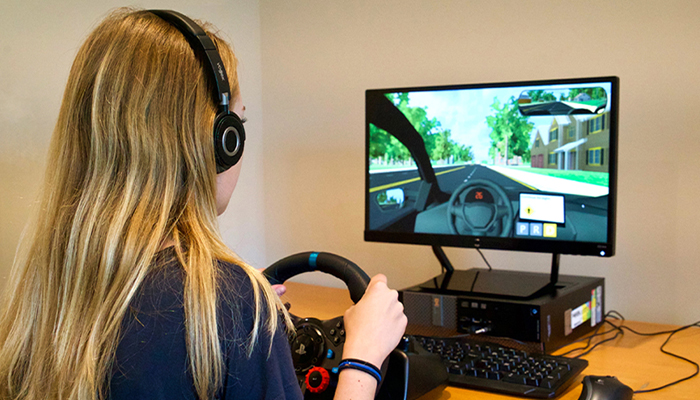HOW CAN WE HELP YOU? Call 1-800-TRY-CHOP
In This Section
Can a Virtual Driving Assessment Help Predict Time to First Crash in New Young Drivers?

Researchers analyzed virtual driving assessments to determine if driving skills measured at the time of licensure could help predict crash risk in newly licensed young drivers.
The findings:
Researchers used a virtual driving assessment (VDA) to examine how driving skills measured at the time of licensure contribute to crash risk post-licensure in newly licensed young drivers in Ohio. They classified individuals into skill clusters and summary driving classes based on performance on the VDA. Key results include:
- The "No Issues" driving class (careful and skilled drivers showing no issues on the VDA) had a crash risk 10% lower than average.
- The worst performing driving class "Major Issues with Dangerous Behavior" (drivers with more control issues that cause sudden, jerky movements and more reckless behavior) had a crash risk 11% higher than average.
Why it matters:
Although young drivers comprised a little more than 5% of licensed drivers in 2020, they made up 12% of all drivers involved in police-reported crashes and more than 8% of all drivers in fatal crashes. The results of this study are a stepping stone to identifying the drivers at risk of crashing early in licensure, as well as some of the skills that may help prevent future crashes. This study is also crucial to developing better prediction models and providing targeted, personalized interventions in the future through actionable feedback and training in skillsets that may need continued improvement even after licensure.
Who conducted the study:
Children's Hospital of Philadelphia researchers who led the study include first author and Research Scientist Elizabeth Walshe, PhD in the Center for Injury Research and Prevention; co-authors Allison E. Curry, PhD, MPH, director of Epidemiology and Biostatistics in the Center for Injury Research and Prevention, and Alexander Gonzalez, MS, MBA, senior manager of Research Data Integration in the Department of Biomedical Health Informatics; and senior author Flaura K. Winston, MD, PhD, founder and co-scientific director of the Center for Injury Research and Prevention; along with colleagues from the Annenberg Public Policy Center at the University of Pennsylvania, the University of Michigan, and Drexel University.

Virtual driving assessments are now available at 26 CHOP Primary Care Network offices throughout Pennsylvania and New Jersey.
How they did it:
Researchers analyzed data from 16,914 young drivers under the age of 25 who took the VDA immediately before passing the Ohio state license exam between July 2017 and December 2019. To protect privacy of the data, researchers de-identified the data and converted all dates to age in days from birthdate, including age at permit issuance, license exam attempt, license issuance, and any police-reported crash. Then they derived time since licensure and time to first crash, rounding the crash follow-up time to 15-day intervals to protect individuals' privacy. A Cox proportional hazard model estimated the risk of crash during the follow-up time.
Quick thoughts:
"While the VDA does not capture an individual's entire risk profile, it could be used in combination with other measures of crash-risk skills, attitudes, and behaviors to advance the development of better diagnostic prediction models of crash risk," Dr. Walshe stated. "With this information, programs can be developed that provide personalized and targeted interventions that mitigate skill deficits prior to licensure and in the early period of licensure when crash risk is highest for new drivers."
What's next?
Future studies could explore correlations between training and time- and exposure-varying risks for young drivers.
Where the study was published:
This study appeared in Pediatrics. Also view a corresponding video abstract.


